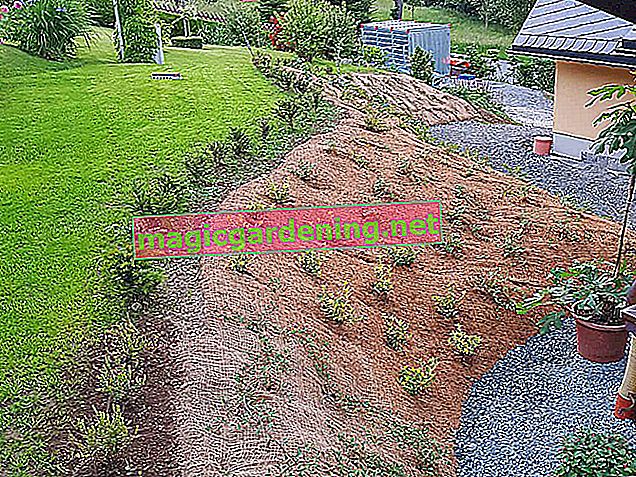
Secure the embankment
A slope can be fixed with different elements. Plants are a very effective variant, but they only have an effect when the plants have grown well. These elements will help fix the slope:
- Natural stones
- Plant stones
- Wooden boards
- Branches
- Planting mats
- Gabions
- Mulch
- Bushes
- Ground cover
also read
- Plant the slope with ground cover
- Plant the roof terrace: trees, grass, climbing plants and more
- Plant the pergola
Create terraces
Planting alone will not be enough on very steep slopes. Instead, it makes sense to create terraces by placing horizontally low walls in the ground at regular intervals. Natural stones are a cheap and attractive option, and gabions are also popular due to their easy installation. If you have wood or branches left over, you can also secure the slope with boards or woven fences.
Planting mats
An invisible variant is the use of plant mats. These are spread out over the slope and attached to the sides using stones, for example. Then holes are cut in the places where plants will be planted. To cover the plant mat until the plants have spread out, you can cover them with gravel or mulch (€ 213.00 at Amazon *).
Plant an embankment
Which plants are best suited for the embankment depends mainly on the slope and the orientation of the sky. While practically anything can be grown on flat slopes, deep-rooted perennials and shrubs should be grown on very steep slopes, which cling to the slope and thus prevent erosion.
A combination of shrubs and ground cover makes sense, as ground cover forms a kind of network and thus also protects the embankment from erosion.
Deep-rooted shrubs for steep slopes
Various shrubs and bushes can be used for planting on slopes. When making your choice, pay attention to the desired height and the preferences regarding the location. If you put sun-seeking shrubs in shady locations, they will only grow poorly and possibly die. On the other hand, shade-loving plants burn in the blazing sun.
| Surname | Stature | Winter protection necessary | Location preferences |
|---|---|---|---|
| Bensengine | 0.5 to 3 meters | Yes | Full sun |
| Boxwood | 2 to 6 meters | No | Shady to partially shaded |
| yew | 0.5 to 1.5 meters | No, evergreen | Sunny to shady |
| Firethorn | 2 to 4 meters | Rather no | Sunny to partial shade |
| Common juniper | 1 to 8 meters | No | Sunny to partial shade |
| Dog rose | 2 to 3 meters | No | Sunny |
| Laurel medlar | 3 to 8 meters | Rather no, evergreen | Partial shade |
| Oregon grape | Up to 1.5m | No | Sunny to partial shade |
| Paper bush | Approx. 1 meter | No | Sunny to partial shade |
| Thuja | Up to 10 meters | No | Sunny to partial shade |
| Bird cherry | 5 to 10 meters | No | Sunny to partial shade |
| Holly | 1.5 to 3 meters | No | Protected, partially shaded |
| Witch hazel | 2 to 6 meters | No, blooms in winter | Sunny, protected |
You can find further suggestions for easy-care plants for your embankment here.
Water the slope plants
Planning the water supply is particularly important for hillside planting. Put an automatic irrigation system, (69.29 € on Amazon *) you don't have to worry about accessibility. However, if you want to water yourself with a hose or even with the watering can, you should create paths on your slope so that you can easily reach all places.








